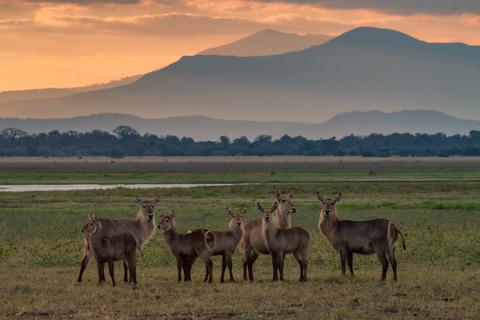当前位置:
X-MOL 学术
›
Anim. Conserv.
›
论文详情
Our official English website, www.x-mol.net, welcomes your
feedback! (Note: you will need to create a separate account there.)
Postwar wildlife recovery in an African savanna: evaluating patterns and drivers of species occupancy and richness
Animal Conservation ( IF 2.8 ) Pub Date : 2020-12-14 , DOI: 10.1111/acv.12661 K. M. Gaynor 1, 2 , J. H. Daskin 3 , L. N. Rich 1, 4 , J. S. Brashares 1
Animal Conservation ( IF 2.8 ) Pub Date : 2020-12-14 , DOI: 10.1111/acv.12661 K. M. Gaynor 1, 2 , J. H. Daskin 3 , L. N. Rich 1, 4 , J. S. Brashares 1
Affiliation

|
As local and global disturbances reshape African savannas, an understanding of how animal communities recover and respond to landscape features can inform conservation and restoration. Here, we explored the spatial ecology of a wildlife community in Gorongosa National Park, Mozambique, where conservation efforts have fostered the recovery of large mammal populations after their near-extirpation during Mozambique’s civil war. We deployed a grid of 60 camera traps and used a hierarchical, multi-species occupancy modeling approach to examine patterns of occupancy and its environmental and anthropogenic correlates for different functional groups and species. Our survey provides strong evidence that wildlife in Gorongosa is recovering. Throughout the study area, modeled species richness was comparable to richness in less-disturbed savanna systems in Tanzania and Botswana, and exceeded estimates of richness from a mixed-use landscape outside the park and from postwar (1997–2002) aerial surveys. However, the mammal community in Gorongosa differs from prewar conditions and from those of more intact systems, with few large carnivores, low occupancy probabilities for large ungulate species that were dominant prior to the war, and high occupancy for other ungulates that are now ubiquitous. Associations with tree cover varied among species and guilds. Contrary to our expectation, there was no effect of lake proximity on community and group-level occupancy, and previously dominant floodplain ungulate species now occupy more wooded areas. Mammals were more likely to occupy areas that burned frequently, as post-fire vegetation regrowth provides high-quality forage, highlighting the importance of Gorongosa’s fire regime. Occupancy was lower in areas with more illegal hunting, and higher closer to roads, potentially because roads were established in areas of high wildlife density and facilitate animal movement. Continued multi-species monitoring in Gorongosa can shed light on the different recovery trajectories of ungulate species and the consequences of ongoing large carnivore restoration, guiding conservation interventions.
中文翻译:

非洲大草原的战后野生动物恢复:评估物种占有率和丰富度的模式和驱动因素
随着当地和全球的干扰重塑非洲大草原,了解动物群落如何恢复和对景观特征的反应可以为保护和恢复提供信息。在这里,我们探索了莫桑比克戈龙戈萨国家公园野生动物群落的空间生态学,在莫桑比克内战期间,大型哺乳动物种群在濒临灭绝后的保护工作促进了它们的恢复。我们部署了一个由 60 个相机陷阱组成的网格,并使用分层的多物种占用建模方法来检查占用模式及其不同功能组和物种的环境和人为相关性。我们的调查提供了强有力的证据,证明戈龙戈萨的野生动物正在恢复。在整个研究区域,模拟的物种丰富度与坦桑尼亚和博茨瓦纳较少受干扰的热带稀树草原系统的丰富度相当,并且超过了公园外混合用途景观和战后(1997-2002)航空调查对丰富度的估计。然而,戈龙戈萨的哺乳动物群落与战前条件和更完整的系统不同,大型食肉动物很少,战前占主导地位的大型有蹄类动物的占有率很低,而现在无处不在的其他有蹄类动物的占有率很高。与树木覆盖的关联因物种和行会而异。与我们的预期相反,湖泊附近对社区和群体级别的占用率没有影响,以前占优势的洪泛区有蹄类动物现在占据了更多的林区。哺乳动物更有可能占据经常燃烧的区域,由于火灾后植被再生提供了高质量的草料,突出了戈龙戈萨火灾制度的重要性。非法狩猎较多的地区入住率较低,而靠近道路的地区入住率较高,这可能是因为道路建在野生动物密度高的地区,便于动物移动。在戈龙戈萨继续进行多物种监测可以揭示有蹄类动物物种的不同恢复轨迹以及正在进行的大型食肉动物恢复的后果,从而指导保护干预。
更新日期:2020-12-14
中文翻译:

非洲大草原的战后野生动物恢复:评估物种占有率和丰富度的模式和驱动因素
随着当地和全球的干扰重塑非洲大草原,了解动物群落如何恢复和对景观特征的反应可以为保护和恢复提供信息。在这里,我们探索了莫桑比克戈龙戈萨国家公园野生动物群落的空间生态学,在莫桑比克内战期间,大型哺乳动物种群在濒临灭绝后的保护工作促进了它们的恢复。我们部署了一个由 60 个相机陷阱组成的网格,并使用分层的多物种占用建模方法来检查占用模式及其不同功能组和物种的环境和人为相关性。我们的调查提供了强有力的证据,证明戈龙戈萨的野生动物正在恢复。在整个研究区域,模拟的物种丰富度与坦桑尼亚和博茨瓦纳较少受干扰的热带稀树草原系统的丰富度相当,并且超过了公园外混合用途景观和战后(1997-2002)航空调查对丰富度的估计。然而,戈龙戈萨的哺乳动物群落与战前条件和更完整的系统不同,大型食肉动物很少,战前占主导地位的大型有蹄类动物的占有率很低,而现在无处不在的其他有蹄类动物的占有率很高。与树木覆盖的关联因物种和行会而异。与我们的预期相反,湖泊附近对社区和群体级别的占用率没有影响,以前占优势的洪泛区有蹄类动物现在占据了更多的林区。哺乳动物更有可能占据经常燃烧的区域,由于火灾后植被再生提供了高质量的草料,突出了戈龙戈萨火灾制度的重要性。非法狩猎较多的地区入住率较低,而靠近道路的地区入住率较高,这可能是因为道路建在野生动物密度高的地区,便于动物移动。在戈龙戈萨继续进行多物种监测可以揭示有蹄类动物物种的不同恢复轨迹以及正在进行的大型食肉动物恢复的后果,从而指导保护干预。











































 京公网安备 11010802027423号
京公网安备 11010802027423号